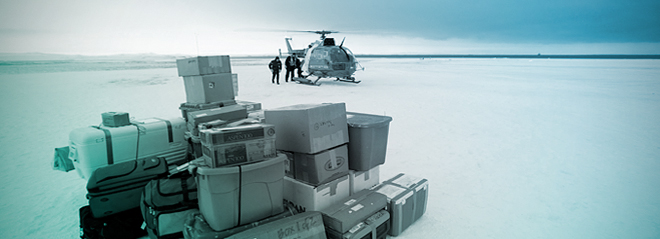|
|

|
|

|
|

|
|

What are snow science and snow cover?
Snow refers both to ice crystals formed in the atmosphere and to the layers formed by these crystals on the Earth's surface. My main interests are in the snow cover. The snow cover (also commonly called snowpack) can be studied for many purposes including avalanche research, climate, atmospheric chemistry, oceanography and biology. Takuvik research topics are focused on how the snow cover interacts with climate, atmospheric chemistry, and sea ice.

Why is it important to study the snow cover ?
During the boreal winter, snow covers most land masses north of 50°N, a significant fraction of land masses between 40 and 50 °N, the whole Arctic ocean and Antarctica, representing 14% of the Earth's surface, i.e. 71 millions square kilometers. This is equivallent to the combined areas of Africa, North America and South America, or to the combined areas of the world's 9 largest countries : Russia, Canada, China, USA, Brasil, Australia, India, Argentina, and Kazakhstan.
Snow is the most reflective material on the Earth's surface: pure snow reflects over 96% of incident visible radiation. Snow therefore has an enormous climatic impact, and its disapearance replaces reflective surfaces with absorbing ones, which amplifies the effects of the current global warming trend. Snow also forms a thermal insulator that limits sea ice growth and ground cooling. This is another facet of its climatic impact. An important aspect of this that we are interested in is the evolution of permafrost and its possible accelerated thawing because of snow-climate interactions.
Snow is a porous medium through which air circulates easily. In fact snow is usually made up of 60 to 80% air by volume. Snow is also transparent and it is irradiated by sunlight. Some of the impurities contained in the snow are activated by sunlight and this initiates complex chemical reactions leading to the release to the atmosphere of pollutants such as nitrogen oxides, aldehydes, halogenated organics and ozone. The intense sunlight affecting these high elevation, low latitude glaciers turns this snow into an extremely efficient photochemical reactor that processes precursors such as organics and nitrate, leading to the formation of pollutants we like to think of as urban.
Understanding these various climatic and chemical aspects requires the study of snow physics, snow chemistry, and of air-snow interactions. Applications include the understanding of snow-permafrost climate interactions.





